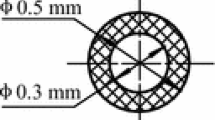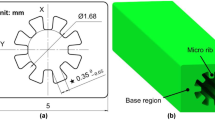Abstract
In this study, to eliminate the extrudate swell, melt fracture and extrudate distortion problems of polypropylene (PP) micro-tube, the experiments of gas-assisted extrusion forming was firstly carried out. Meanwhile, a set of modified gas-assisted extrusion system was set-up, and a kind of novel gas-assisted die was also designed and manufactured. Under the role of gas-assisted extrusion system, PP micro-tubes were successfully prepared. Moreover, the macroscopic and microscopic qualities of PP micro-tubes for gas-assisted extrusion were obtained and compared with those of the traditional extrusion. Experimental results show that gas-assisted extrusion not only overcomes extrudate swell, but also greatly improves the smoothness and transparency of PP micro-tube. In addition, to ascertain the mechanisms of gas-assisted extrusion of PP micro-tube, numerical simulations were also performed. The swell ratios, flow velocities, pressure and stresses distributions of melt for gas-assisted extrusion and traditional extrusion were analyzed and compared. Moreover, the effects of inner cavity’s gases pressures and traction force on the gas-assisted extrusion of PP micro-tube were numerically investigated and discussed with the traditional extrusion. Numerical results show that the swell ratio of PP micro-tube increases with the inlet volume flow rate for traditional extrusion, but it is nearly equal to 0 for the gas-assisted extrusion. Moreover, due to the assistance of gas-layers, not only the axial flow velocity of melt is uniformed and radial flow velocity is removed, but also the pressure, shear stress and first normal stress difference of melt are all greatly reduced, especially at the outlet of die. These weakened pressure and stresses diminish the elastic energy storage and tensile stress of melt, and finally result in the elimination of extrudate swell, melt fracture and extrudate distortion. With the increase of inner cavity’s pressure, the inner and outer radiuses of the gas-assisted extrusion of PP micro-tube all increase, but the wall thickness decreases because the swell ratios of inner radius are all larger than that of the outer radius. In addition, under the same traction force, the sizes of gas-assisted extrusion of PP micro-tube are smaller than that of the traditional extrusion, although the sizes for the both extrusions of PP micro-tube all exponentially decrease with the increase of traction force. Moreover, the extrudate radial swell and melt fracture problems for the traditional extrusion are always existed at the outlet of die although the radial swell of melt decreases with the increase of traction force. However, the extrudate swell and melt fracture problems are greatly removed by the gas-assisted extrusion.

















Similar content being viewed by others
References
Fu XY, Wang Z, Wang H, Wang YT, Jenkins MW, Rollins AM (2014) Fiber-optic catheter-based polarization-sensitive OCT for radio-frequency ablation monitoring. Opt Lett 39(17):5066–5069
Zhang K, Maier F, Krafft AJ, Reiner U, Wolfhard S, Michael B (2013) Tracking of an interventional catheter with a ferromagnetic tip using dual-echo projections. J Magn Reson 234:176–183
Jin GB, Wang MJ, Zhao DY, Tian HQ, Jin YF (2014) Design and experiments of extrusion die for polypropylene five-lumen micro tube. J Mater Process Tech 214(1):50–59
Jin GB, Zhao DY, Wang MJ, Jin YF, Tian HQ, Zhang J (2015) Study on design and experiments of extrusion die for polypropylene single-lumen micro tubes. Microsys Tech 21(11):2495–2503
Tang D, Fang WL, Fan XH, Li DY, Peng YH (2014) Effect of die design in microchannel tube extrusion. Process Eng 81:628–633
Jin GB, Wang MJ, Zhao DY, Tian HQ (2012) Experimental investigation of extrusion process of double-lumen micro tube. Chin J Mech Eng 48(24):19–27
Chen YW (2012) Research on the processing of PA11 micro-tube precision extrusion. M. Thesis. South China University of Technology, Guangzhou, 41–55
Gong X (2009) Flow simulation of micro tubing extrusion die and study of micro tubing processing. Dissertation, South China University of Technology
Zheng JL (2012) Computer simulation of micro-tube extrusion process. Dissertation, South China University of Technology
Chen YH (2013) Analysis of draw flow field and deformation control during extrusion of polymer catheter. Dissertation, Central South University
Venkata RN, Dixit PM, Lal GK (1996) Analysis of axisymmetric tube extrusion. Int J Mach Tool Manu 36(11):1253–1267
Chitkara NR, Butt MA (1997) Combined rod and tube extrusion: numerical solution of axi-symmetric slip-line fields and associated velocity fields. Int J Mech Sci 39(4):435–454
Chitkara NR, Butt MA (1997) Axi-symmetric tube extrusion through a flat-faced circular die: numerical construction of slip-line fields and associated velocity fields. Int J Mech Sci 39(3):341–366
Zhang HG, Khalid L, Abderrahim M, Maia JM (2016) A nonlinear shear and elongation rheological study of interfacial failure in compatible bilayer systems. J Rheol 60(1):1–23
Fredrickson AG, Bird RB (1958) Non-Newtonian flow in annuli. Ind Eng Chem Res 50(3):347–352
Jaisinghani R (1974) Annular flow of a Casson fluid. Dissertation, University of Winsconsin-Milwaukee
Luo XL, Mitsoulis E (1989) Memory phenomena in extrudate swell simulations for annular dies. J Rheol 33(8):1307–1327
Pinho FT, Oliveira PJ (2000) Axial annular flow of a nonlinear viscoelastic fluid-an analytical solution. J Non-Newton Fluid Mech 93(2-3):325–337
Chen CS, Chen SC, Liaw WL (2008) Rheological behavior of POM polymer melt flowing through micro-channels. Eur Polym J 44(6):1891–1898
Intawong N, Wiratket A, Meechue P (2014) Flow visualization & extrudate swell behavior of natural rubber compound in annular die capillary rheometer. Polímeros 24(4):434–440
Intawong N, Udomsom S, Sugtakchan K, Sitticharoen W (2015) Influence of flow pattern development at die entrance and inside annular die on extrudate swell behavior of NR compound. Polímeros 25(5):508–513
Tian H, Zhao D, Wang M, Jin G, Jin Y (2015) Study on extrudate swell of polypropylene in double-lumen micro profile extrusion. J Mater Process Tech 225:357–368
Mu Y, Zhao G, Wu X, Zhai J (2013) Finite-element simulation of polymer flow and Extrudate swell through hollow profile extrusion die with the multimode differential viscoelastic model. Adv Polym Technol 32(S1):E1–E19
Ren Z, Huang XY (2017) Effect of die’s annual width on the extrudate swell of plastic tube. IOP Conf Series: Mater Sci Eng 207:012054
Ren Z, Huang XY (2018) Effect of geometric scale on the extrudate swell of plastic micro-tubes. IOP Conf. Series: Mater Sci Eng 301:012048
Baldi F, Briatico-Vangosa F, Franceschini A (2014) Experimental study of the melt fracture behavior of filled high-density polyethylene melts. Polym Eng Sci 54(2):364–377
Ren Z, Huang XY, Xiong ZH (2018) Numerical studies of temperature effect on the extrusion fracture and swell of plastic micro-pipe. IOP Conf. Series: Mater Sci Eng 322:022036
Hristov V, Vlachopoulos J (2007) A study of viscoelasticity and extrudate distortions of wood polymer composites. Rheol Acta 46(5):773–783
Lee JM, Kim BM, Kang CG (2005) Effects of chamber shapes of porthole die on elastic deformation and extrusion process in condenser tube extrusion. Mater Design 26(4):327–336
Migler KB, Lavallee C, Dillon MP, Woods SS, Gettinger CL (2001) Visualizing the elimination of sharkskin through fluoropolymer additives: coating and polymer–polymer slippage. J Rheol 45(2):565–581
Kulikov O, Hormung K (2003) A simple way to suppress surface defects in the processing of polyethylene. In: Proceedings of twelfth international conference of deformation. Yield and Fracture of Polymers, Cambridge, pp 411–414
Norhayani O, Bashar J, Parisa M, Hatzikiriakos SG (2012) Wall slip and melt fracture of poly(lactides). Rheol Acta 51:357–369
Liu YJ (2006) Elastic behavior analysis of polymer melt extruding through capillary with an additional sinusoidal vibration. Polym Bull 56:599–606
Chen K, Zhou N, Liu B, Wen S (2010) Effect of vibration extrusion on the structure and properties of high-density polyethylene pipes. Polym Inter 58:117–123
Ren Z, Huang XY, Liu HS, Deng XZ, He JT (2015) Numerical and experimental studies for gas assisted extrusion forming of molten polypropylene. J Appl Polym Sci 132:12365–12377
Ren Z, Huang XY (2016) 3D numerical simulation of the hollow square-typed polymer based on gas-assisted extrusion method. Mater Sci Forum 86:189–194
Bhati P, Bhatnagar N (2017) Effect of processing parameters on surface hydrophilicity of porous PLA tubes prepared by gas assisted microcellular extrusion foaming technique. Mater Lett 209:602–605
Anyasodor DN (2014) Fundamental studies on the blow forming of polymeric micro-tubes and components. Dissertation, University of Strathclyde,
Brzoskowski R, White JL, Szydlowski W, Weissert FC, Nakajima N, Min K (1987) Air-lubricated die for extrusion of rubber compounds. Rubber Chem Tech 60(5):945–956
Liang RF, Mackley MR (2001) The gas-assisted extrusion of molten polyethylene. J Rheol 45(1):211–226
Huang XY, Liu HS, Zhou GF, Luo ZM, Li SY (2005) The experimental study of air-assisted extrusion of polymer. Chin Plast 19:17–19
Liu HS, He JT, Huang XY, Deng XZ, Wan QF (2014) Numerical simulation and experimental validation of die swell deformation in L-shaped profile gas-assisted coextrusion. Polym Mater Sci Eng 30:113–116
Xiao JH, Liu HS, Huang XY (2009) Slip length of gas-assisted extrusion die influence on die swell ratio. Chin J Plast 38:115–117
Deng XZ, Liu HS, Huang YB, Huang XY, He JT (2016) Comparison of two methods for gas layer in gas-assisted precision co-extrusion molding. J Cent South Univ (Sci Tech) 47:2227–2234
Ren Z, Huang XY, Liu HS, Deng XZ, He JT (2015) Non-isothermal viscoelastic numerical analysis of compressible gas-assisted polymer extrusion molding. Ciesc J 4:1615–1623
Ren Z, Huang XY, Liu HS, Deng XZ (2016) Experiment and simulation on the effect of gas pressure on polymer gas assisted extrusion forming. J Sichuan Univ 48:1–8
Ren Z, Huang XY, Liu HS (2016) Three dimensional viscoelastic numerical simulation of gas-assisted extrusions for hollow profile polymer melt. J Cent South Univ 47:1128–1135
ANSYS Inc (2012) ANSYS POLYFLOW 14.5 User’s Guide, ANSYS. Inc., Southpointe
Thien NP, Tanner RI (1977) A new constitutive equation derived from network theory. J Non-Newton Fluid Mech 2(4):353–365
Vlachopoulos J, Alam M (1972) Critcal stress and recoverable shear for polymer melt fracture. Polym Eng Sci 12(3):184–192
Kim S, Dealy JM (2002) Gross melt fracture of polyethylene. I: a criterion based on tensile stress. Polym Eng Sci 42(3):482–494
Funding
This study was funded by National Natural Science Foundation of China (grant number 51763011, and 61764006) Natural Science Outstanding Youth Foundation Project of Jiangxi Province (grant number 2018ACB21006), Top-notch Talent Foundation Project of JXSTNU (grant number 2014QNBJRC004), and Doctor Start-up Foundation Project of JXSTNU (grant number 2017BSQD021).
Author information
Authors and Affiliations
Corresponding author
Ethics declarations
Conflict of interest
The authors declare that they have no any conflict of interest.
Additional information
Publisher’s note
Springer Nature remains neutral with regard to jurisdictional claims in published maps and institutional affiliations.
Rights and permissions
About this article
Cite this article
Ren, Z., Huang, X. & Xiong, Z. Experimental and numerical studies for the gas-assisted extrusion forming of polypropylene micro-tube. Int J Mater Form 13, 235–256 (2020). https://doi.org/10.1007/s12289-019-01482-7
Received:
Accepted:
Published:
Issue Date:
DOI: https://doi.org/10.1007/s12289-019-01482-7




